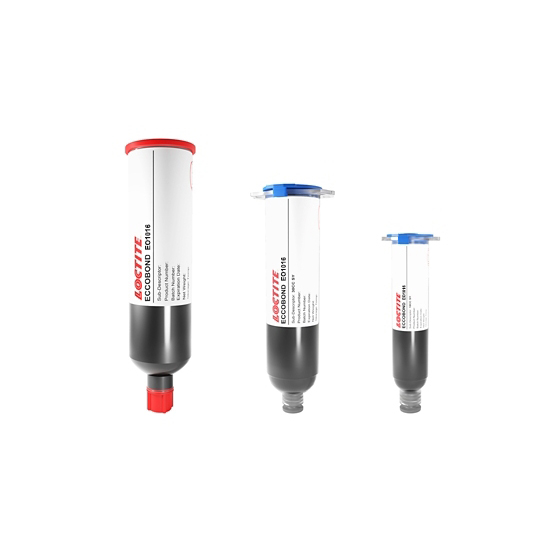LOCTITE ECCOBOND EO1016
- Glob top Encapsulant
- Smartcard applications
- Fast curing
Product Description
LOCTITE® ECCOBOND EO1016 is an epoxy encapsulant intended for applications requiring excellent handling properties. The cured material survives severe thermal shock and offers continuous service to 177 °C. It is particularly suited for use on transistors and similar semiconductors, can be used for encapsulation of watch ICs. Additionally it exhibits a UL94V-0 rating and its non abrasive filler allows for grinding when this is necessary. It is an ideal product for glob top smartcard encapsulation.
LOCTITE® ECCOBOND EO1016 was used for years in the Swiss Watch making industry and was the Glob Top used to encapsulate the Watch ICs. An important difference with this product is that it is a "EO" family which stands for "Epoxy One Component" which means that it is premixed and refrigerated. The storage temperature of this product is only refrigerated 5C as opposed to the more reactive -40C products.
Cure Schedule
- 20 minutes @ 150°C
- 24 hours @ 93°C
Technical Specifications
| General Properties | |||||||
| Pot Life Pot Life Pot life is the amount of time it takes for the viscosity of a material to double (or quadruple for lower viscosity materials) in room temperature after a material is mixed. It is closely related to work life but it is not application dependent, less precise and more of a general indication of how fast a system is going to cure. | 2184 hours | ||||||
| Specific Gravity Specific Gravity Specific gravity (SG) is the ratio of the density of a substance to the density of a reference substance; equivalently, it is the ratio of the mass of a substance to the mass of a reference substance for the same given volume. For liquids, the reference substance is almost always water (1), while for gases, it is air (1.18) at room temperature. Specific gravity is unitless. | 1.56 | ||||||
| |||||||
| Physical Properties | |||||||
| Thixotropic index Thixotropic index Thixotropic Index is a ratio of a material s viscosity at two different speeds in Ambient temperature, generally different by a factor of ten. A thixotropic material s viscosity will decrease as agitation or pressure is increased. It indicates the capability of a material to hold its shape. Mayonnaise is a great example of this. It holds its shape very well, but when a shear stress is applied, the material easily spreads. It helps in choosing a material in accordance to the application, dispense method and viscosity of a material. | 1.1 | ||||||
| Viscosity Viscosity Viscosity is a measurement of a fluid’s resistance to flow. Viscosity is commonly measured in centiPoise (cP). One cP is defined as the viscosity of water and all other viscosities are derived from this base. MPa is another common unit with a 1:1 conversion to cP. A product like honey would have a much higher viscosity -around 10,000 cPs- compared to water. As a result, honey would flow much slower out of a tipped glass than water would. The viscosity of a material can be decreased with an increase in temperature in order to better suit an application | 62,000 mPa.s | ||||||
| Chemical Properties | |||||||
| |||||||
| Electrical Properties | |||||||
| |||||||
| Mechanical Properties | |||||||
| Elongation Elongation Elongation is the process of lengthening something. It is a percentage that measures the initial, unstressed, length compared to the length of the material right before it breaks. It is commonly referred to as Ultimate Elongation or Tensile Elongation at break. | 1.8 % | ||||||
| Thermal Properties | |||||||
| |||||||
| Glass Transition Temperature (Tg) Glass Transition Temperature (Tg) The glass transition temperature for organic adhesives is a temperature region where the polymers change from glassy and brittle to soft and rubbery. Increasing the temperature further continues the softening process as the viscosity drops too. Temperatures between the glass transition temperature and below the decomposition point of the adhesive are the best region for bonding. The glass-transition temperature Tg of a material characterizes the range of temperatures over which this glass transition occurs. | 126 °C | ||||||
| Thermal Conductivity Thermal Conductivity Thermal conductivity describes the ability of a material to conduct heat. It is required by power packages in order to dissipate heat and maintain stable electrical performance. Thermal conductivity units are [W/(m K)] in the SI system and [Btu/(hr ft °F)] in the Imperial system. | 0.39 W/m.K | ||||||





